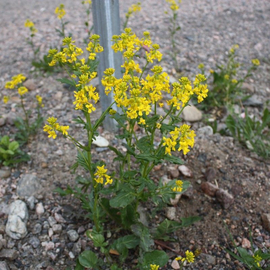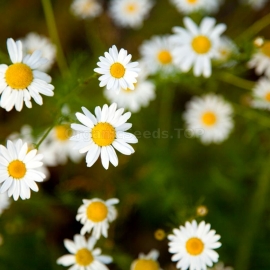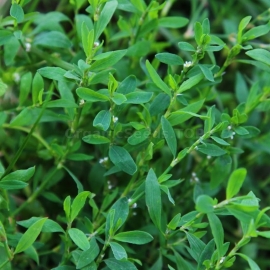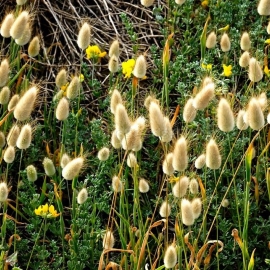


Organic Wintercress seeds
1.14 €
A perennial plant with lower lyre-pinnately dissected leaves with a large rounded-oval terminal lobe, a good honey plant; autumn sowings provide early green food in the spring.
-
Wintercress, or alternatively winter rocket, rocketcress, yellow rocketcress, yellow rocket, wound rocket, herb barbara, creases, or creasy greens / Barbarea vulgaris
Forage, green manure and honey crops. Improves the physical and phytosanitary condition of soils, significantly increases productivity, and is superior to winter rape in winter hardiness.
Crescent is a perennial plant with lower lyre-pinnately dissected leaves with a large round-oval terminal lobe. The upper leaves are sessile, ovate, incised-toothed. The flowers are golden yellow, fragrant, with four petals and one pistil. Inflorescences are dense racemes. The fruits are dehiscent straight or bent pods. The pods are cylindrical, tetrahedral, with veins sticking out obliquely upward. Height 30-80cm.
It blooms in spring and early summer for about a month, bears fruit in June-July starting from the second year of the growing season. After the fruiting period, the above-ground parts of the plant die off, and a new flowering and fruiting stem develops from the root collar every spring.
Propagated by seeds and root shoots. Maximum fertility - up to 10 thousand seeds. The minimum temperature for seed germination is 6-8°C, the maximum is 38-40°C, the optimal is 18-20°C. Seeds germinate quickly, in summer, autumn and after overwintering in spring, from a depth of no more than 4 cm, preferably from a depth of 0.5 cm. In the first year of life, only a rosette of leaves with a well-developed taproot is formed, which overwinters.
Attitude to moisture and soil fertility: mesophyte, mesotroph. Can grow in partial shade.
A weed plant mainly in the forest zone, it is found less frequently in the south, in places that are excessively moist. It grows in damp meadows, along rivers, in forest clearings, in thickets of bushes, in clearings, along roads, in ditches, in fallow lands and waste areas. Common cress is seeded already at the beginning of summer before field crops are harvested and heavily clogs the soil.
A good honey plant, with nectar productivity from 0.5 to 1.5 kg per 1 sq.m. (depending on soil and climatic conditions). Willingly visited by bees throughout the day, especially in the first half. Bees also collect pollen from the colza.
Autumn crops provide early green food in the spring. After decomposition in the soil, biomass becomes an easily digestible fertilizer, forms humus, which enriches the soil with nutrients and improves its structure.
Mow and close up in the fall, before flowering, with a Fokin flat cutter or cultivator. Humification processes take place only in the presence of moisture in the soil.
With this product buy
Product code: 2319
1.71 €
Perennial ground cover native to Europe. Cultivated worldwide. Plants grow thickly to interlock, forming an aromatic lawn which may be mowed to maintain close-cropped. A nice place for an afternoon nap.
Product code: 2699
3.00 €
An annual herb with a height of 10-80 cm, which every year reproduces by self-seeding, a polymorphic species of the genus Highlander, a group of similar and difficult to distinguish species is united under the general name.
Product code: 12549
1.14 €
A shimmering ocean of blue purple flowers awaits all those who plant this impressive plant in their garden. This plant is commonly known as Meadow Sage and is a pollinator plant! Beautiful bright blue, almost purple flowers spike off of a long green stem.
Product code: 15213
1.14 €
Inflorescence spike-paniculate, compact, broadly ovate or capitate, up to 4 cm long, glumes are very narrow, densely pubescent, which gives the hairy inflorescence the appearance of a hare's tail, the lower floral scales with long geniculate.




